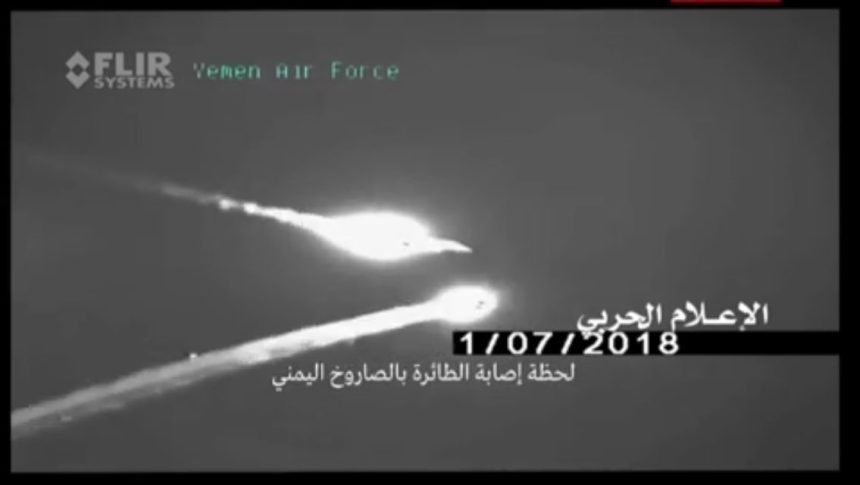FLIR Images Show F-15 Shoot-Down, Weapon Used May Have Been Repurposed AAM.
Images and video have surfaced of what is claimed to be a Royal Saudi Air Force F-15 Eagle being shot down by an unspecified surface to air (SAM) missile over Yemen’s capital city of Sanaa. The video is alleged to have been obtained using a ground-mounted forward-looking infra-red sensor usually mounted on helicopters for surveillance and targeting: most probably a Flir Systems ULTRA 8500.
The clip appears to show an F-15 Eagle, version unknown.
The video is shot from the right side of the aircraft, and as the aircraft rolls right, the height of the starboard (right) vertical stabilizer/rudder appears to be shorter than normal on an F-15, as though part of it is already missing: someone suggested that may have already sustained damaged to at least one of its vertical stabilizers even though this seems to be a bit far-fetched based on the available clip.

Immediately after this right rolling maneuver two bright objects, glowing from their heat signature in the infra-red video, are separated from the aircraft that lit the afterburners (based on the glowing . These seem to be flares, countermeasures ejected against heat-seeking surface-to-air missiles.

The aircraft then rolls right again and the profile of the F-15’s canopy can be seen, appearing to be a single-seat version, but difficult to confirm from the poor quality infra-red video.
A large object enters the frame from below, presumably a surface-to-air missile, either impacts the F-15 (whose engine heat signature has increased, suggesting the use of afterburner) or possibly detonates a proximity warhead near it or against a flare. The video ends without showing what happened to the F-15 following the apparent missile hit. The aircraft seems to continue flying more or less unscathed.

Text in the YouTube video caption reads in Arabic, “The first sight of the moment hit and shot down a Saudi F-15 aircraft in the atmosphere of the Yemeni capital Sanaa” (the image used as preview in the video below does not show the RSAF F-15 but the Russian Air Force Su-24 hit by a Turkish AF F-16 in November 2015..).
Information that surfaced on Twitter shortly after the video released suggested the aircraft may have been shot down by a S-75 Dvina surface-to-air missile, a version of the venerable SA-2 Guideline SAM missile. However several sources are increasingly suggesting the F-15 was targeted by a modified R-27T based on claims that Houthis have modified a number AAMs (air-to-air missiles) to be launched from pick-ups.
The R-27 (AA-10 Alamo-B), is an IR-homing, missile with a maximum range of 63 km and a theoretical maximum allowed vertical separation of 10 km meters altitude.
If the claim of the F-15 aircraft being shot down by Houthis is confirmed, this may be one of the few instances any version of the F-15 Eagle has been shot down. The U.S. suffered the loss of F-15E Strike Eagles to anti-aircraft fire during the Gulf War back in 1991.
The Royal Saudi Air Force is believed to have a fleet of 129 active single-seat F-15C Eagles and F-15S ground attack/multi-role aircraft along with the first 13 (of 84 ordered) new F-15SA attack aircraft,

In October 2017, the Houthi rebels claimed to have shot down a Saudi Typhoon involved in a mission supporting Operation Decisive Storm, the Saudi-led air war on the Houthi rebels in the southern end of the Arabian Peninsula.
H/T @phxasc for providing many details about the alleged downing.









